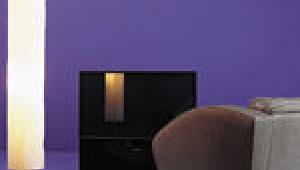Having a Ball with HDTV
High-definition television isn't just about movies. Another killer app is making the case for an HDTV in every home: sports. Highfalutin videophile talk about the ability to see what the director intended pales beside the sports fan's visceral need to follow the ball and watch the action develop. Sports bars are where many fans get their first taste of sports on HDTV. The falling price of HDTVs has created the irresistible urge to bring the experience home. Plus, at home you can add a good surround sound system. A Dolby Digital 5.1 soundtrack that captures the roar of the crowd only adds to the excitement.

Most of us have access to DTV broadcasts. According to the National Association of Broadcasters (NAB), as of May 7, 2002, 304 DTV stations were operating in 104 markets, reaching roughly three-quarters of U.S. households. Dozens more will join the total by the time you read this, although, according to the U.S. General Accounting Office, about 74 percent of broadcasters missed the May 1, 2002, deadline for the start of digital transmissions. Things aren't so bad in the top 30 markets, where 95 percent of the major network affiliates are on the air with DTV. The laggards are mainly smaller stations. (For a complete list of operating DTV stations, go to www.hometheatermag.com/hdtv2.shtml or www.nab.org/newsroom/issues/digitaltv/dtv-stations.asp.) The metro areas with the richest assortment of DTV offerings are Houston, Indianapolis, and Portland, all of which the NAB has proclaimed Digital TV Zones. The most undigital zone is New York City, where several broadcasters were knocked off the air with the destruction of the World Trade Center.
 While most TVs in U.S. homes are still analog, that's changing fast. DTV sales passed the million mark in 2001 with 1.46 million sold, according to the Consumer Electronics Association (CEA). By next year, that figure is expected to more than double to 4 million. By 2006, when Washington may or may not cut off analog broadcasting, the CEA estimates that there will be 10.5 million DTVs in American homes.
While most TVs in U.S. homes are still analog, that's changing fast. DTV sales passed the million mark in 2001 with 1.46 million sold, according to the Consumer Electronics Association (CEA). By next year, that figure is expected to more than double to 4 million. By 2006, when Washington may or may not cut off analog broadcasting, the CEA estimates that there will be 10.5 million DTVs in American homes.
Go Wide, Young Man
HDTV is changing the visual style of sports programming. The most significant difference is that production teams can use more wide shots, pulling back to show how plays are developing. Explains Martin D. Franks, executive vice president of CBS: "In football, the classic TV shot of the last 50 years was tackle-to-tackle on the quarterback, and you didn't see the wide receivers, except maybe their feet. We can now pull back farther—not only because of the aspect ratio but because of the greater resolution. You see more of the field and more of the action, and there's still enough resolution to read the players' names on their backs. So, now you're seeing the wide receiver work on the free safety as the quarterback is dropping back to pass.
"Similarly, in basketball, the way we tried to shoot the Final Four [in HD] was from just inside the half-court circle to the backboard so that you can see the other players moving without the ball. In golf, HD gives a 3-D effect. You see more of the hills on the course and the undulation of the green. People have the same reaction as a first-time visitor to Augusta."
A Different Visual Style
Getting those panoramic shots means convincing the director and cameramen to shoot in a different style. "It's important that the cameraman, who has been shooting it a different way for 50 years, realizes that he can stay wide," says Franks.

Adds Philip Garvin, cofounder and general manager of HDNet: "We're very clear to our directors about how to direct a game [in HD] differently than a regular game. Sometimes, we're not able to use standard-def directors because it's such a different thing. We have a horrible time with standard-def cameramen."
In addition to wide shots, there may be other new choices. "We also like other angles," says Garvin. "The high end-zone shot—the attack of the defense over the goal—is actually a good way to watch hockey. We also find that low-angle shots, where the camera is close to the action but very wide, provide the best experience of the game."
According to Garvin, a busy visual style doesn't play well on huge HDTV screens. "It's best to set your camera and leave it. If you move the camera too much, it becomes too disorienting and too dizzying on a big screen. The high-def viewer doesn't want to see a lot of cutting or fancy effects—too distracting. We like to see the game action. It's all about composition, camera selection, and camera movement."
- Log in or register to post comments


























































